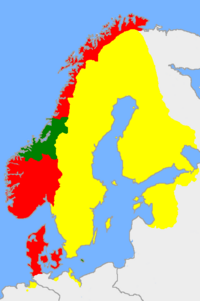Treaty of Copenhagen (1660) facts for kids
| Type | Bilateral treaty |
|---|---|
| Signed | 27 May 1660 |
| Location | Copenhagen, Denmark |
| Original signatories |
|
| Ratifiers |
|
The Treaty of Copenhagen (Danish: Freden i København, Swedish: Freden i Köpenhamn) was a very important agreement. It was signed on May 27, 1660, in Copenhagen, Denmark. This treaty officially ended the Second Northern War. This war was fought between the Swedish Empire and an alliance of Denmark-Norway and the Polish–Lithuanian Commonwealth.
This treaty was like a follow-up to an earlier agreement called the Treaty of Roskilde. The Treaty of Copenhagen helped to clearly set the borders between Denmark, Sweden, and Norway. These borders are almost the same even today.
Contents
Why the Treaty Was Needed
After the Treaty of Roskilde, there were still some disagreements. Charles X of Sweden wanted to keep Akershus county. In return, he would give back Trøndelag and Bornholm to Denmark-Norway. But Frederick III of Denmark did not want to follow the Roskilde treaty anymore. He wanted things to go back to how they were after an even older treaty from 1645.
Both kings were very determined. So, other powerful countries had to step in to help. France and England supported Sweden. The Dutch Republic helped Denmark. These countries tried to bring the two sides to an agreement.
Frederick of Denmark worried that if Sweden controlled the area called Scania, it would always threaten Copenhagen. He suggested that Denmark and the Netherlands team up to take Scania back. Other countries like Brandenburg and Austria agreed with him.
However, the Dutch and English had their own concerns. They wanted to make sure that one country didn't control both sides of the Øresund strait. This strait was important for trade in the Baltic Sea. If one country controlled both sides, they could raise the Øresund toll, which would hurt trade. Also, a powerful French leader, Cardinal Jules Mazarin, warned the Netherlands not to help Denmark too much against Sweden.
How the Peace Talks Began
In February 1660, King Charles X of Sweden died. When Frederick of Denmark heard this, he immediately said the Treaty of Roskilde was no longer valid. This worried the Swedish representatives. But their French and English helpers told them that if Sweden gave up its claim to Trøndelag but stuck to the other parts of the Roskilde treaty, France and England would make sure a new treaty happened.
Denmark, with support from Brandenburg, Austria, and Poland, still wanted the Scanian lands back. But this time, the Dutch did not agree with Denmark. On March 8, 1660, a Dutch admiral named Michiel de Ruyter was told to leave the harbor where he had trapped the Swedish fleet. This showed that the Dutch were not going to push for Denmark's demands anymore.
So, Frederick of Denmark had to give in. The serious talks for the new treaty began on March 24.
Key Discussions and Agreements
One of the hardest parts of the talks was about the island of Bornholm. The people of Bornholm had fought against the Swedish soldiers who were occupying their island. They even killed the Swedish commander. They were afraid of what would happen if the island stayed under Swedish control.
King Frederick had promised to protect his loyal people on Bornholm. He kept his promise by demanding that Bornholm be returned to Denmark. This was a tough demand, even with threats from Sweden and the other countries helping with the talks. It was then suggested that Denmark could give up some land owned by Danish noble families in Scania to Sweden as a trade-off for Bornholm.
At one point, the talks became difficult because the representatives from the mediating countries started getting involved in their own plans. These plans weren't always what Denmark or Sweden wanted. A Danish leader named Hannibal Sehested suggested that Denmark and Sweden should just talk directly. Both sides agreed, and in just a few days, they worked out the details of the treaty.
What the Treaty Decided

On May 27, the Treaty of Copenhagen was signed. The signing happened in tents set up between Copenhagen and the Swedish army camp. Four days later, the remaining Swedish soldiers, about 3,000 of them, finally left the area around Copenhagen.
Here are the main things the treaty decided:
- Sweden got to keep the lands east of the Øresund strait. These included the island of Ven, Scania, Halland, Blekinge, and Bohuslän.
- Sweden no longer had to pay the Sound Dues. These were tolls paid for ships passing through the Øresund strait.
- Trøndelag, an area that included Nordmøre and Romsdal, was given back to Norway. The island of Bornholm was returned to Denmark.
- All Danish and Norwegian forts that Sweden had captured had to be given back. This had to happen within two weeks after the treaty was officially approved.
- Sweden received some estates (large properties) in Scania. This was in exchange for giving Bornholm back to Denmark. The Danish king later paid back the nobles who owned these estates with other lands in Denmark.
- Denmark agreed to pay 3,500 riksdaler each year. This money was for maintaining the beacons (lights) that guided ships between Skagen in Denmark and Falsterbo in Sweden.
- All prisoners of war from both sides were to be set free.
- All previous agreements between Denmark and Sweden were confirmed.
See also
 In Spanish: Tratado de Copenhague para niños
In Spanish: Tratado de Copenhague para niños
- List of treaties

